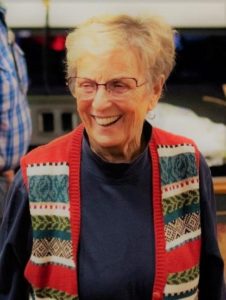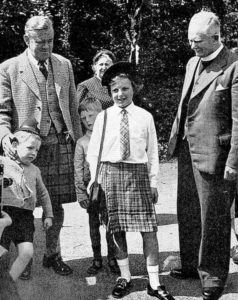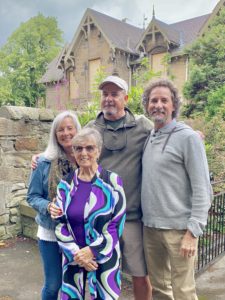My dear friend Larry Zwisohn just sent me another gem, this time from The Billboard, a trade publication started in 1894. Early in the 20th century, The Billboard covered just about all facets of the entertainment industry, from indoor theaters to outdoor events. They settled for specializing on music genres due to Variety’s focus on the movie industry. According to Larry, “The Billboard was never known for in-depth articles about entertainers, but they made an exception for Roy and Dale.” Following is what Billboard had to say about my folks:
BOX OFFICE MAGIC by Bernie Asbell
When he returned from the Wisconsin State Fair last August, Herb Dotten, the outdoor editor of The Billboard asked if I would go down to the Kentucky State Fair to meet Roy Rogers, watch him work and do a story about him. “Why me?,” was the only reaction I could come up with. He wanted the story because experienced men in the trade had signed Roy for numerous state fairs. All of them were optimistic, but when they counted up the bucks at the end of each run, these men were flabbergasted. Even their long years of experience couldn’t help them explain the special magic Roy Rogers has for pulling crowds through a box office. Instead of a dollars and cents story, he wanted something about the magic, seen through the cold eyes of an outsider, a chump. That’s me.
The next morning I was on a plane to Louisville. On the way, I looked over some notes from The Billboard’s files. Here, roughly, is the picture I shaped up: For years Roy Rogers had been pyramiding on his motion picture popularity by appearing as guest star at rodeos. For about 10 years he was top-liner at the Madison Square Garden Rodeo and another regular stop was the Houston Fat Stock Show.
In 1956, Sam Cashman, the manager of the Ohio State Fair, cornered Roy at the Houston show and suggested that Roy ought to draw pretty good at fairs. In fact, he asked Roy to come to Ohio that very year. “How about a guarantee?” asked Roy. Cashman came up with an immediate and readily acceptable proposition. If the fair could take the first $10,000 to get off their nut, Roy could keep the next $40,000. “And how about after that?” Roy asked. Cashman said that in 101 years, no show at the Ohio Fair had ever topped $47,000. But for the record, he suggested, Roy could take 75 per cent of any overage.
In five days at Ohio, eight shows in all, Rogers grossed $135,000. His take was $94,000. He earned as much in any two of those five days, unless I miss my guess, as the governor of Ohio is paid in a whole year.
That December, the outdoor convention at the Sherman Hotel in Chicago was buzzing with the name of Roy Rogers. Everybody suddenly wanted him. But for the following summer he was already committed to a schedule of shooting TV shows, he couldn’t make any fairs. Except there was one hole in his schedule, the last week of September. The only thing going that late was the New Mexico State Fair. Roy’s first reaction: “There are no people in New Mexico.” But he was persuaded to take the date and he soon found out otherwise.
A pre-show in downtown Albuquerque brought out more people to wave at Roy Rogers and Dale Evans than the city had ever seen in one place in its history. Police were called out to the box office to control the lines of ticket buyers. On opening night the brand new coliseum was packed with 12,000 seat holders and 1,400 standees. Nine performances in five days pulled in $160,000 and Rogers rode off with 100 grand.
Leon Harms, the fair manager, happy when he first signed Roy, was astounded. He said he had sought Rogers because he wanted to open his new Coliseum with a big blast. He figured the blast would cause him a deficit of $20,000 but, instead, he netted that amount at the box office alone, not figuring big increases at the outside gate and the biggest midway grosses in the fair’s history. These he all attributed to the newly discovered Roy Rogers magic.
If any skeptics doubted the Rogers magic, they must have become converts in 1958. That year Rogers booked four major fair dates — Wisconsin, Nebraska, Kentucky and Eastern States — and his triumphs continued with (if you will excuse the phrase) monotonous regularity.
In Milwaukee, where the previous grandstand record was $84,511, set in 1953, manager Bill Masterson hoped fondly that with a name like Rogers he might crack the $100,000 mark for the first time. But when the people started to pour in, somebody forgot to shut off the spigot. After the 10-show run, $200,000 was in the till. The fair’s share alone, something like $70,000, was more than the total gross for the previous year’s showing of “West-O-Rama.” Rogers hauled off with better than 100G for his end. Perhaps the most impressive accomplishment of the Wisconsin run was the show of Wednesday, August 20. All afternoon it had rained but at starting time, when it was still sprinkling, 14,000 people filled the stands and overflowed into chairs set along a tarpaulin on the race track. For an hour and 10 minutes, it alternately rained and drizzled until it finally poured. But the drenched performers continued and the crowd stayed.
The following week, at the Nebraska State Fair in Lincoln, another whopper: $93,000 grossed in six shows. From there the Rogers company moved on to Louisville. And, that’s where I was headed. An hour after landing, I was having lunch with Roy Rogers at the Brown Suburban Hotel.
Roy was all friendliness and smiles. Writers for show business trade papers get used to a certain kind of smile they find on the faces of performers. These are professional smiles, manufactured for people who can do you some good. But not Roy’s. I don’t think he gave two hoots who put his name in the paper and who didn’t. He needed more publicity like he needed higher income tax. His was a smile of a fellow who was happy and liked to talk to people. You had to like him right off. We talked about fairs and his success at them seemed no puzzle at all to Roy. “A state fair is America’s family show. Once a year the whole family, every member of every age, has something in common. Even the teenagers go for the 4-H and Future Farmer’s activities. Families like families, and I’m a family kind of fellow. I think it gets across to the people.”
A few minutes later, Dale Evans came by and suddenly the table was swarming with kids — all Rogers kids. First there was Linda Lou, more a lady than a kid. She is 15 and what a doll. Then two boys, Dusty 112 and Sandy 11. Then their two adopted six-year old girls, Dodie, a Choctaw Indian lass, and Debbie, a little Korean beauty. (So you think it’s easy to tell a Korean from an American Indian? Try it with these two. I kept getting confused all day.) Of the two boys, Dusty and Sandy, one is Roy’s natural son and one adopted. But I kept having to consult my program book to tell which is which. You’d never know by watching the attitudes of Roy and Dale. (My sister, Marion and I were already married by the summer of 1958.)
Dale apologized for being late. She’d been packing. Immediately after the Kentucky fair, she was flying back to California with the kids for the opening of school. That struck me as odd. I’d have thought a family on tour, knocking down money like $10 to $20,000 a day, would put first things first; that is, a few days of money before a few days of school. But Dale has her own way of putting first things first. “The kids have been having fun and I always enjoy doing shows with Roy,” she told me, as though she was talking about spending a couple of days at the beach. “But I’m a mother first. Don’t you think that’s the right thing?”
Then another odd thing happened to give me a new slant on Roy Rogers, box-office phenomenon. A young mother and her little boy approached Roy, a pen in her hand for an autograph. The kid wasn’t dragging mommy. She was dragging the kid. The kid stood there wide-eyed. But mommy was pop-eyed, all flushed and a-twitter. Then she hauled out a camera. At that moment, Roy’s tour manager, Mike North, leaned over to me. “You think she wants Roy’s picture with her kid? Just watch. She’s going to ask you or me to snap the picture so she can get in it too.” As though it had been staged, sure enough, she turned to Mike and began to ask, “Would you mind. . . .” “Sure,” he said. It obviously happens all the time.
I began to look at Roy in a new way. Just because he’s a kids’ star doesn’t mean he was born yesterday. His skin was smooth and shiny, and his walk was vigorous, but alongside his narrow leprechaun eyes, creases were showing. Then a few facts I had read on the airplane began to register. His first movie, “Under Western Stars,” voted the best western of the year, was made in 1938 — 20 years ago. Today’s generation of young parents was the generation that discovered Roy Rogers. Just as the generation was sold by their parents on Babe Ruth and Charles Lindbergh, so they are selling Roy Rogers to today’s kids. Roy Rogers is what parents and kids today can have in common — they can all be kids together. I began to understand the mother and her camera, and began to understand, too, something about those huge box-office grosses. When Roy rides into town, mom and dad don’t say, “No,” Junior, you can’t have that.” Eagerly they say, “Let’s go!” But I knew that couldn’t be the whole magic.
That afternoon came the first let-down. I was sitting high up in the new Kentucky Fair Coliseum with Willis Freitag, assistant manager of the Wisconsin State Fair, who was paying a neighborly visit. The show was going well enough, but where were the crowds I had been hearing so much about? Maybe 3 or 4,000 were scattered around. Ten thousand seats were empty. “This’ll build, you watch,” Freitag kept saying. “This is a real family show. These people will go home tonight and somebody will call them on the phone. They’ll start talking about Roy Rogers. Watch how even the musical director, Rafael Mendez, brings his two sons out of the band and they play a trumpet trio. They’re medical students at Stanford, identical twins. This is all family stuff. Watch now how Roy brings out those kids of his one by one and tells a story about each. You can’t beat that sincerity of his and you can’t fake it either. He just gets across to people.”
“Back in Wisconsin, he opened the night before the Fair actually opened. We had 5,050 people there. More than half the stands were empty, just like this. I said to everybody it was going to build. Next night we had an overflow and it never let up. I can feel it, it’s going to build here too.” That night, the same story. Almost 3 or 4,000 in the stands. It’s hard for any show to sparkle when the house isn’t full of people. But for me, each of these crowds presented a dramatic moment I won’t soon forget.
At the close, Roy asked all the kids, wherever they were , to come down to the front railing so he could meet them all. They all came, and parents came with them. Then, Roy, riding Trigger, Jr., slowly circled the rail, his hand extended towards the thousands of little hands grasping outward. You can’t shake thousands of hands that way but you can touch them. And, I think Roy must have touched them all, just riding by slowly to say, “hello.”
You can call it a gimmick if you like, but an honest, sincere gimmick has to be invented by an honest, sincere guy. You can’t tell lies for long under a glaring spotlight. I remarked about this to Dorothy O’Brien, Mike North’s secretary. Like me, she is new to the outdoor show world, this being her first tour. “You think you’ve seen this man?” she asked. “Tomorrow, after lunch, he’s visiting an armory full of mentally retarded children. You go with him. Then you’ll see.”
At 12:30 the next day we drove off. Three American Legionnaires in the front seat, organizers of the event, and Roy, Dale and me in the back. All during the five minute ride, Roy kept apologizing in advance because he’d have to leave so quickly. With an afternoon show coming up, he could stay only 15 minutes. “What’ll we do there?” he asked Dale. “You always think of something,” she said, “maybe there’s a piano.” “There’s a piano,” a Legionnaire said. “Don’t know if it’s ever been tuned, but it’s there.”
When Roy and Dale entered the gymnasium, a bigger roar went up then he had got at the Coliseum. Instead of heading for the stage, Roy and Dale, each steered for separate corners of the audience. They worked their way up the rows, picking up kids, taking the hands of others, kissing them, chatting, mussing the hair of a few. Mothers stood back, their eyes glued to the glowing faces of their kids as though they had never seen them like that before.
These kids weren’t pretty. Their eyes didn’t focus right. Their arms were either too skinny or too fat, and they flapped awkwardly. Some were in wheelchairs. A few were not kids at all, but teenagers with baby faces and baby sounds. They were easy to pity but not easy to love. But there was love all over the faces of their surprised mothers — and all over Roy Rogers and Dale Evans.
Roy and Dale leaped up on the stage and, asking no help of the Legionnaires, they began to roll forward the piano. Dale began to play and Roy began to sing. More cheers went up and it settled into the most peculiar applause I had ever heard. These kids didn’t know they were supposed to wait till the end of the song. The musical sounds made them happy and, when one of them couldn’t contain himself, he just shrieked or stood up and clapped. It was the most beautiful chaos I had ever seen. A kid would roll his eyes toward his mother, hunch his shoulders in delight, then let out a whoop. After half a dozen songs, Roy and Dale came down from the platform. They didn’t dart for the door, as I had seen celebrities do for years, but they worked their way around the room again. Kids reached out just to touch. And all of them got a touch.
Back in the quiet of the car, it was time for somebody to say something profound. But nobody did. Roy just said,”These are the kids nobody cared about til a couple of years ago. People used to hide them. Nobody can really know what it is until it happens in his own family, and then you know what it’s all about.” One of the Legionnaires, reaching for the right thing to say, settled for, “Roy, you and Dale were just great.” Roy shrugged, “Dale and I just believe in trying to be ourselves. People seem to take to it.” I realized that after a lot of years of trade reporting, I had just seen something new in show business.
Later, in the Coliseum, I looked at the near empty seats as people slowly trickled in. Roy and Dale were in the dressing room. The trickle kept going on and on. Suddenly, I turned to Willis Freitag, who was watching too. It was show time and the trickle kept coming. The Coliseum had filled to three-quarters and they kept coming. A man came running back and told Mike North that there was a bottleneck at the box-office. People were lined up to get tickets. Could the show be held up for 15 minutes? Ten minutes later, the hall was jammed.
As a visiting fireman, I thought I might take upon myself a certain little pleasure of breaking the news. I knocked on the door of Roy and Dale’s dressing room. Roy popped his head out. “What’s holding things up?” he asked. “They waiting for a cash customer out there?” “Roy, the house out there is full. Every last seat.” Roy’s eyebrows arched upward thoughtfully. “That so,” he said quietly. “I guess our little prayers have been answered.” That was one I had never heard before.



